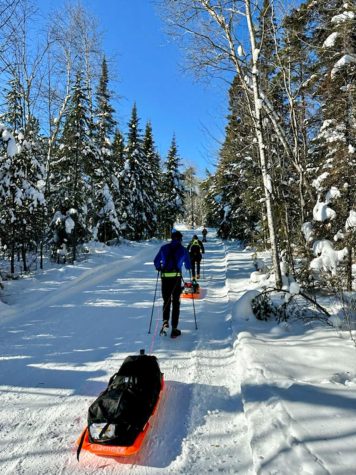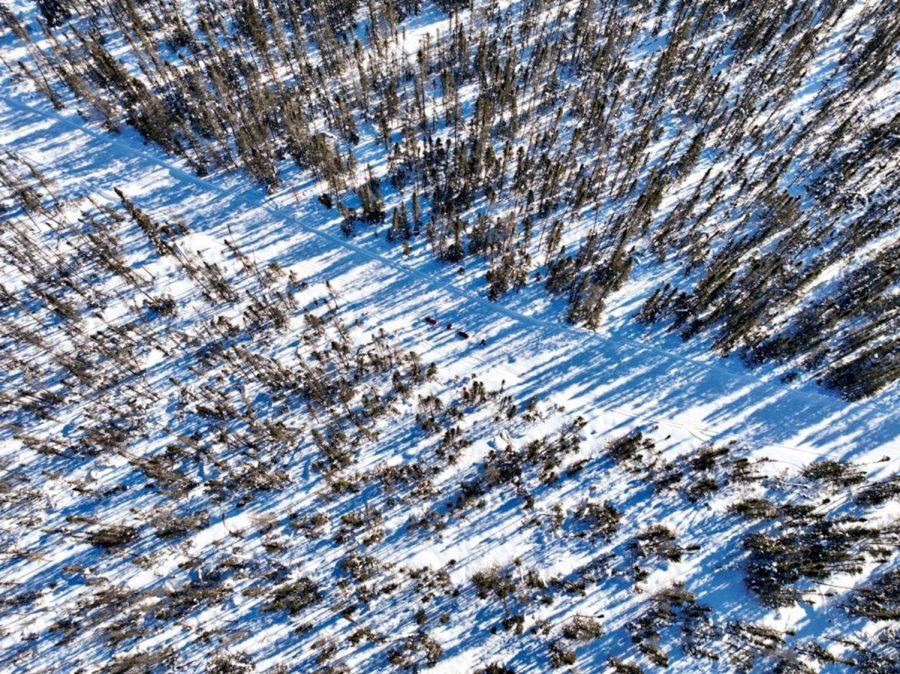Meditations of an Ultramarathoner
February 9, 2023
The Arrowhead 135 is a 135 mile ultramarathon from International Falls, Minn. to Tower, Minn. on snowmobile trails. Racers either run, ski or bike. This year, I was on foot. In short, it was an awesome gulp from life’s punchbowl.
Event dealings began on Sunday, Jan. 29,with a check of required survival gear, a dropoff of a bag full of calories for pickup at the race’s halfway point and a pre-race meeting.
The next day, on the morning of Jan. 30, I arrived with all my gear at the starting line, where it was a balmy -27˚F. Racers enjoyed a fireworks display, the race director yelled “release the hounds” and we were off. Soon, the sun came up. It mercifully took the edge off the cold. The celestial sphere treated racers to an almost completely uninterrupted display of sun, moon, stars and planets—astoundingly beautiful. The lack of wind this year was also quite welcome. I found myself pondering before the Gateway store (the first of three official race checkpoints) my first lesson of the day—even when confronted with significant adversity (in this case, the cold), which is easy to fixate on, life has a way of throwing you a bone. It’s up to you to find the mercy and beauty, which is always there.
After making the turn onto the Arrowhead trail around mile 10, I was able to spend some time with the spirit of my Ph.D. advisor, Jason Saleeby, who unexpectedly passed away the week prior. It was helpful to have the time, space and natural setting to process this loss of a man who was my scientific compass and who was like a second father to me.
Around mile 20, I began leapfrogging with a fellow racer. After a few miles we locked into the same pace and started chatting, not knowing that we would share the next 100 plus miles and over 30 hours together—for which I am super grateful! I love this about ultramarathons—they’re the best way to make fast friends.
Up to this point and for the majority of the event, I was able to take in 200-400 calories per hour and stay hydrated.
I rolled into the Gateway checkpoint around 3:30 p.m. on Jan. 30;there, I refueled with soup and coffee, and refilled my water bottles with boiling water. I was back on the trail in 20 minutes. The friend I drove up with was there to meet me and got some amazing drone imagery.
It got dark and cooled off not long after leaving Gateway. I donned my headlamp and added my unzipped puffy jacket as my outermost layer. In the 20 miles or so before Melgeorge’s (a nice warm cabin that serves as the second checkpoint at about the halfway point,) the trail becomes hillier. I welcomed the opportunity to use different muscles, use trekking poles on the uphills and sled the descents. From here until about mile 120 I felt like a kid who got to go for an all-night sledding session, eating candy the entire time.
I was ready for Melgeorge’s cabin by the time my trail buddy and I arrived there at 2:15 a.m. The final approach involves a trek across Elephant lake, which was windy last year (when I skied the event) and was no different this year. Ski goggles went on at that point to avoid freezing my corneas. I walked in the door, grabbed my drop bag, and was treated to the best grilled cheese sandwich I’ve ever had, some mashed potatoes and a couple cups of 7-Up. I charged my tracker and watch, set my alarm for two hours and hopped in my sleeping bag for the most restorative nap ever. My trail buddy had the same plan, so upon waking we hit the trail at 5:15 a.m., feeling refreshed. We’d escaped Melgeorge’s trap of comforts—historically over 80% of folks who do so finish. This year it was 93%.
The next stretch involved even more amazing sledding than before. Each hill seemed better than the last. Before we knew it, it was light enough to turn off the headlamp. It’s official—day two! The journey to the next and final checkpoint (Embark) was slow as my pace had dropped to between three and three-point-five mph, but I was amazed that my body had sort of reached a steady state where it was no longer deteriorating.
We left Embark just before 6 p.m. feeling great. The “Wakemup Hill” follows about two miles down the trail—the climb up it was burly but it rewards you with the most fun descent of the course, where I hit 25 mph. So much fun!

Now for my personal crux of the race! The trail crosses Olson Rd. where a course marking suggests racers take a right (west) to parallel the road for a bit. I did so for about one-tenth of a mile and something didn’t feel right (only a couple bike tracks on the trail and some footprints—many of which were headed east) so I checked the course GPX file loaded on Gaia, which showed I was going the wrong way. My buddy and I returned to the road crossing and followed the trail south. Slightly shaken by the navigational snafu, chilled from the time spent standing still and fatigued, I went into a bit of a panic. I had to address the cold (I was beginning to shiver) before it became a problem so over the course of about an hour I added each remaining layer I had—eight freakin’ layers (!!); on bottom I took off my pants and was horrified to see only one layer—I had forgotten to put some lower layers back on! I added two more layers and the shivering stopped. Then I began to calm down. I ate and drank just enough to keep moving for the final three hours. While managing these issues, I had the sensation that I was developing new tools for future use should anxiety rear its head in day-to-day life.
The race finishes by traversing about a seven mile stretch of the Lost Lake Peatland Scientific and Natural Area. It felt relentless in its darkness, flatness, featurelessness and coldness. After about two hours we climbed out of the topographic low we were in and began a far more joyous two mile hilly stretch to the finish. The glow in the sky from the Fortune Bay Casino,the finish line, got more intense until we saw the safety fencing that corrals you into the finish, where a half-dozen kind folks had gathered to welcome us to the finish, shortly before two a.m. on Feb. 1. The pilgrimage was complete at 42 hours and 41 minutes! I tied for 8th overall (my buddy was the female champion). At the finish line, you go through a check to make sure you still have all mandatory gear. The altered state I was in made this experience pretty surreal. Upon passing the gear check, we got our finisher medals, some soup, swapped some stories with fellow finishers and passed out around 3 a.m. I am feeling very lucky to have the support of amazing race officials, volunteers, friends and family. One week later I am still awash with good vibes and gratitude.
It’s interesting how calm I feel after confronting tasks that dismantle me physically, mentally and spiritually. Weeks, months and years spent working toward something really big never fails to permanently alter me for the better. On the other hand, so much comfort exists in many of our day-to-day lives, but certainly not all. Without discomfort, we have no need to develop personal tools to help us when life gets hard (and it does get crushingly hard, at some point, for everyone). So I urge those reading this (congratulations on getting this far) to work toward something uncomfortably hard — it doesn’t have to be a winter ultramarathon —embrace the occasional slog of the process, build those tools for managing adversity and enjoy the ride!
Much love,
Alan
(My favorite quote from Race Director Ken Krueger this year, “do your part to keep the finishing rate around 50%. This doesn’t mean I don’t want to see you all finish. I genuinely do. Half of you this year, the other half next year.”)













